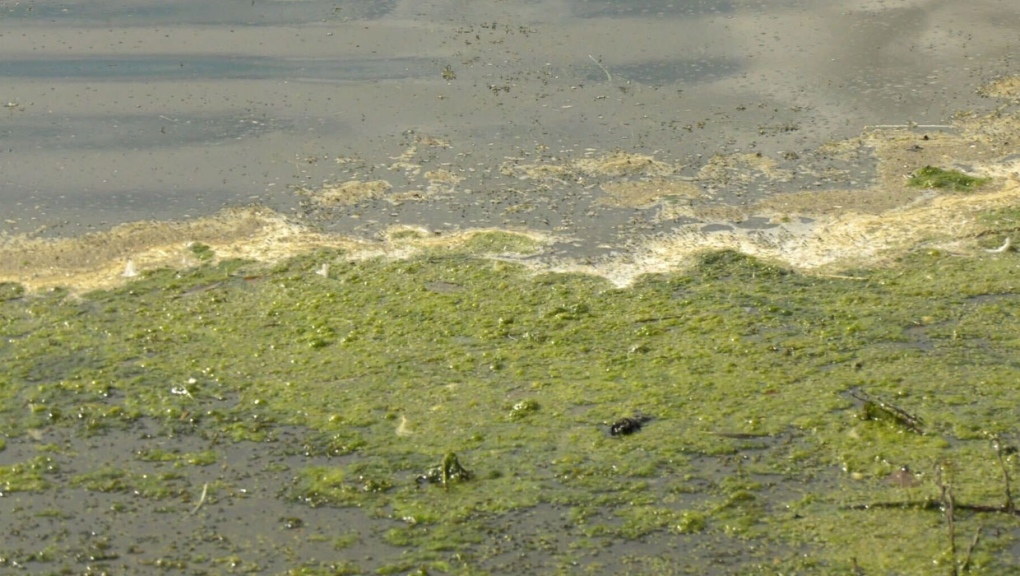'Avoid all contact': Strathmore residents, visitors told to avoid areas of Eagle Lake
 Alberta Health Services says blue-green algae can cause skin irritation, rash, sore eyes, sore throats, nausea, vomiting and diarrhea in people that come into contact with it. (File)
Alberta Health Services says blue-green algae can cause skin irritation, rash, sore eyes, sore throats, nausea, vomiting and diarrhea in people that come into contact with it. (File)
Health officials are advising nearby residents and visitors take precautions because of the presence of blue-green algae in a Strathmore lake.
The bloom of cyanobacteria, which looks like scum, grass clippings, fuzz or globs on the surface of the water, can cause skin irritation, sore, red eyes and rashes in those that come into contact with it.
Anyone who manages to ingest infected water may experience a sore throat, swollen lips, fever, nausea and vomiting and/or diarrhea.
"Symptoms usually appear within one to three hours and resolve in one to two days," Alberta Health Services (AHS) said in a release.
"Symptoms in children are often more pronounced; however, all humans are at risk of these symptoms.
"Exposure to the bacteria may be fatal to pets."
As a result of the presence of the algae, AHS says everyone must stay out of the water until further notice.
"Avoid all contact with blue-green algae (cyanobacteria) blooms. If contact occurs, wash with tap water as soon as possible," officials said.
Whole fish and fish trimmings from Eagle Lake should not be fed to pets and people should consider limiting what they eat from it.
Albertans should not drink or cook with any untreated water taken directly from any recreational lake and boiling the water will not remove the toxins produced by the blue-green algae, AHS says.
The water should not be used on edible plants either.
"This is particularly important for plants with edible parts exposed to the ground surface (such as cabbage, lettuce, tomatoes, and other salad vegetables)," AHS said.
Any location where the bloom is not visible is safe for recreational purposes, but AHS says the bloom could move from one location to another because of weather or wind.
More information on blue-green algae can be found online.
CTVNews.ca Top Stories

Border agents seize $2M worth of cocaine at Canada-U.S. border
Authorities at the Coutts, Alta., border crossing seized 189 kilograms of cocaine, with an estimated value of about $2 million, that was being shipped into Canada.
'Dangerous person alert' issued for Calgary double murder suspect
Calgary police have issued an emergency alert for an armed man they say is a suspect in the double murder of a father and his daughter.
Matthew Gaudreau's widow welcomes their first child months after his death
Four months after his death, the widow of Matthew Gaudreau announced the birth of their first child. Gaudreau, 29, and his NHL star brother Johnny Gaudreau, 31, were killed after being struck by a driver in August.
Ontario labour ministry investigating injury on Toronto set of 'Beast Games'
Ontario's labour ministry is investigating an industrial accident on the Toronto set of 'Beast Games,' the newly released Prime Video competition series from YouTube star MrBeast.
Toronto police warn of extortion scam where suspects send victims 'graphic violent images'
Toronto police say they're receiving an 'increasing' number of reports about a scam where suspects send their victims 'graphic violent images' in an effort to extort money from them.
The best, worst and weirdest pop culture moments of 2024
You might not remember it all, but CNN took note of every niche pop culture oddity and TikTok fad. And no, perennial history-maker Taylor Swift didn’t even make the cut this year. Helming the highest-grossing tour ever is probably enough recognition.
'McDonald's wouldn't open': Here are B.C.'s 10 worst 911 nuisance calls of the year
What do overripe avocados, stinky cologne and misplaced phones have in common? Generally speaking, none of them warrant a call to 911.
Year in review: Notable people who died in 2024
Here is a roll call of some noteworthy figures who died in 2024.
Halifax airport runway reopens after plane caught fire upon landing
The plane that caught fire upon landing at Halifax's airport over the weekend has been removed, and the runway has reopened.































